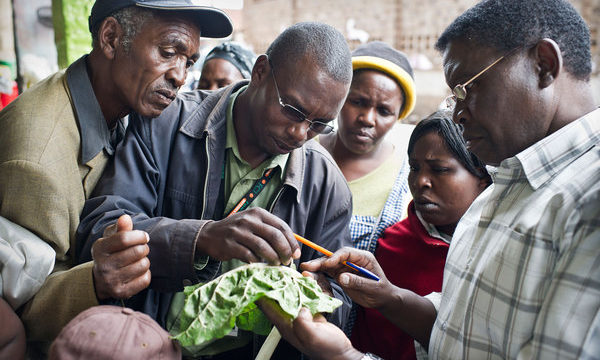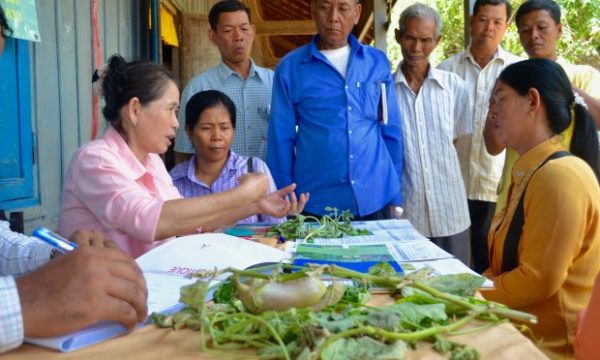By Amy Cruz. Reblogged from the CGIAR CCAFS blog.

Male farmers listen to the facilitator during a focus group discussion in the Tra Hat Climate-Smart Village. The discussions help the researchers understand the pest management and climate change perceptions of rice farmers. Photo: A. Sivapragasam (CABI)
Climate-smart agriculture calls for pest management that controls farm pests and diseases in a way that does not negatively affect ecosystem services and human health.
Climate change affects not only farming practices in that extreme events may flatten trees and crops. It also affects the distributions and life cycles of animals and insects such as pests, disease-causing organisms and crop-pollinating insects and animals. Farmers in Vietnam speculate that the increase in temperatures brought about by climate change might be favouring certain pests.
To further understand the behavior, control and management of pests and diseases in the light of climate change, the Centre for Agriculture and Biosciences International (CABI) Southeast Asia is conducting “Pest Smart”, a two-year initiative under the CGIAR Research Program on Climate Change, Agriculture and Food Security Southeast Asia (CCAFS SEA) Climate-Smart Villages (CSVs) project.
Pest Smart aims to address issues on crop pests and diseases experienced by the CSVs vis-a-vis climate change. Three focus group discussions with farmers were carried out in Vietnam, Cambodia and Laos as part of the baseline survey.
Farm pests and diseases and their management
The researchers found that in Vietnam, farmer participants did not observe any extreme weather events but some have noticed more erratic rainfalls, longer drought periods and higher temperatures.
Both the women and men farmers echoed the sentiment, “If pesticides are not applied at all, nothing will be left.” The Vietnamese farmers also divulged spraying five times in one cropping season to eradicate thrips, rice leaffolders, case worms, brown planthoppers and panicle mites.
Women farmers were not usually invited to training workshops on integrated pest management, thus, are not aware of the beneficial insects and natural enemies to the different crop pests. It is important that women participate in such workshops, as they usually do important tasks in the household’s agricultural production processes, especially in choosing and buying the pesticides to use.
In Cambodia, the farmers’ foremost problem was rodents, including the rice field rat and a bigger rat species (either the brown rat or the bandicoot rat). Fields may be devastated overnight with these pests. Both the rice field rat and bandicoot rat are trapped and eaten by the farmers; however, this does not seem to abate the rodent population.
Leaffolders and stem borers also infest the rice crops. Farmers spray their crops early during the season, however, doing so disrupts the normal biological controls and weakens crop health. “Brown spot” disease is observed to be prevalent in areas with poor soil health, especially soil with potassium deficiency.
Like the Vietnamese farmers, Laotian farmers noticed erratic changes in weather such as the increase in temperature and less rainfall during the wet season. In Laos, these present a problem especially for farmers who grow vegetables and fruits aside from rice. Rice farmers also have to deal with pests such as thrips, planthoppers, stem borers and blast.
Because of these climate challenges, farmers in all three countries usually consult pesticide retailers to address their pest and disease problems, which increases their likelihood of buying and using pesticides unnecessarily.
Future adaptation actions
The Pest Smart team will use the results of the focus group discussions to develop variables for questionnaires to monitor the changes in farmers’ beliefs and practices in pest management throughout the duration of the project.
The results also showed which interventions could be introduced to the villages, and these were included in a list of recommendations based on identified issues. The farmers need to understand the life cycles of different pests to know the appropriate and effective pesticides for particular conditions. Information, education and communication on the proper use of pesticides may curb the beliefs in the villages that pesticides are needed for a good harvest.
Participatory experiments would also demonstrate how farmers could lessen pesticide use and still maintain good harvests and prevent unnecessary damage to their health and the environment. Pesticide retailers and shop keepers in the villages could also be informed on the regulations regarding the marketing and distribution of pesticides.
Farmers in Vietnam identified adaptation strategies that could help them cope with the effects of climate change like synchronized sowing, selection and use of rice varieties with salinity tolerance and the practice of water-saving methods such as alternate wetting and drying.
These interventions would be integrated into the action plans of the different CSVs to promote climate-smart agriculture. Climate-smart agriculture includes practices and technologies that contribute to greater food security and better climate change mitigation and adaptation.
Read the full article on the CGIAR CCAFS blog →
Related News & Blogs
Plantwise Bangladesh: supporting national crop monitoring
The CGIAR COVID-19 Hub provides a coordinated research response to the global pandemic threatening health systems worldwide, along with posing serious risks to food security and progress towards the Sustainable Development Goals. The Hub focuses on sup…
14 October 2021


